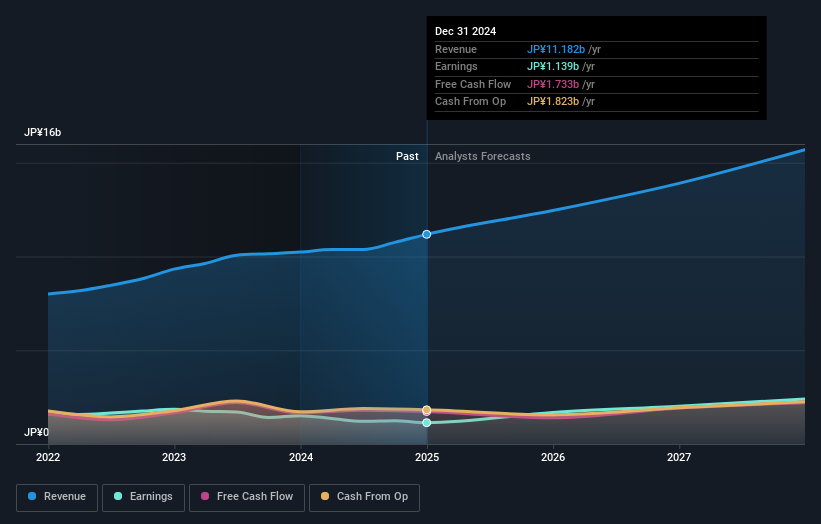- Japan
- /
- Healthtech
- /
- TSE:2150
CareNet, Inc.'s (TSE:2150) 14% loss last week hit both individual investors who own 41% as well as institutions

Key Insights
- The considerable ownership by individual investors in CareNet indicates that they collectively have a greater say in management and business strategy
- The top 7 shareholders own 51% of the company
- 27% of CareNet is held by Institutions
Every investor in CareNet, Inc. (TSE:2150) should be aware of the most powerful shareholder groups. We can see that individual investors own the lion's share in the company with 41% ownership. In other words, the group stands to gain the most (or lose the most) from their investment into the company.
While institutions, who own 27% shares weren’t spared from last week’s JP¥4.1b market cap drop, individual investors as a group suffered the maximum losses
In the chart below, we zoom in on the different ownership groups of CareNet.
See our latest analysis for CareNet

What Does The Institutional Ownership Tell Us About CareNet?
Institutional investors commonly compare their own returns to the returns of a commonly followed index. So they generally do consider buying larger companies that are included in the relevant benchmark index.
We can see that CareNet does have institutional investors; and they hold a good portion of the company's stock. This implies the analysts working for those institutions have looked at the stock and they like it. But just like anyone else, they could be wrong. It is not uncommon to see a big share price drop if two large institutional investors try to sell out of a stock at the same time. So it is worth checking the past earnings trajectory of CareNet, (below). Of course, keep in mind that there are other factors to consider, too.

Hedge funds don't have many shares in CareNet. Our data shows that Medical Incubator Japan K.K. is the largest shareholder with 16% of shares outstanding. In comparison, the second and third largest shareholders hold about 11% and 6.3% of the stock. In addition, we found that Katsuhiro Fujii, the CEO has 0.5% of the shares allocated to their name.
We did some more digging and found that 7 of the top shareholders account for roughly 51% of the register, implying that along with larger shareholders, there are a few smaller shareholders, thereby balancing out each others interests somewhat.
While studying institutional ownership for a company can add value to your research, it is also a good practice to research analyst recommendations to get a deeper understand of a stock's expected performance. There is some analyst coverage of the stock, but it could still become more well known, with time.
Insider Ownership Of CareNet
The definition of an insider can differ slightly between different countries, but members of the board of directors always count. Company management run the business, but the CEO will answer to the board, even if he or she is a member of it.
I generally consider insider ownership to be a good thing. However, on some occasions it makes it more difficult for other shareholders to hold the board accountable for decisions.
Our most recent data indicates that insiders own some shares in CareNet, Inc.. As individuals, the insiders collectively own JP¥1.2b worth of the JP¥26b company. Some would say this shows alignment of interests between shareholders and the board, though we generally prefer to see bigger insider holdings. But it might be worth checking if those insiders have been selling.
General Public Ownership
With a 41% ownership, the general public, mostly comprising of individual investors, have some degree of sway over CareNet. While this group can't necessarily call the shots, it can certainly have a real influence on how the company is run.
Private Equity Ownership
Private equity firms hold a 16% stake in CareNet. This suggests they can be influential in key policy decisions. Some investors might be encouraged by this, since private equity are sometimes able to encourage strategies that help the market see the value in the company. Alternatively, those holders might be exiting the investment after taking it public.
Private Company Ownership
We can see that Private Companies own 6.3%, of the shares on issue. It's hard to draw any conclusions from this fact alone, so its worth looking into who owns those private companies. Sometimes insiders or other related parties have an interest in shares in a public company through a separate private company.
Public Company Ownership
We can see that public companies hold 4.9% of the CareNet shares on issue. We can't be certain but it is quite possible this is a strategic stake. The businesses may be similar, or work together.
Next Steps:
It's always worth thinking about the different groups who own shares in a company. But to understand CareNet better, we need to consider many other factors. Consider risks, for instance. Every company has them, and we've spotted 3 warning signs for CareNet you should know about.
If you are like me, you may want to think about whether this company will grow or shrink. Luckily, you can check this free report showing analyst forecasts for its future .
NB: Figures in this article are calculated using data from the last twelve months, which refer to the 12-month period ending on the last date of the month the financial statement is dated. This may not be consistent with full year annual report figures.
New: AI Stock Screener & Alerts
Our new AI Stock Screener scans the market every day to uncover opportunities.
• Dividend Powerhouses (3%+ Yield)
• Undervalued Small Caps with Insider Buying
• High growth Tech and AI Companies
Or build your own from over 50 metrics.
Have feedback on this article? Concerned about the content? Get in touch with us directly. Alternatively, email editorial-team (at) simplywallst.com.
This article by Simply Wall St is general in nature. We provide commentary based on historical data and analyst forecasts only using an unbiased methodology and our articles are not intended to be financial advice. It does not constitute a recommendation to buy or sell any stock, and does not take account of your objectives, or your financial situation. We aim to bring you long-term focused analysis driven by fundamental data. Note that our analysis may not factor in the latest price-sensitive company announcements or qualitative material. Simply Wall St has no position in any stocks mentioned.
About TSE:2150
CareNet
Engages in the pharmaceutical digital transformation and medical platform businesses in Japan.
Flawless balance sheet with moderate growth potential.
Market Insights
Community Narratives



